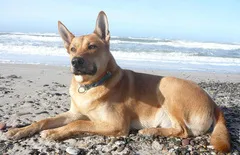
Carolina Dog
The Carolina Dog is a dog of medium build, and it is generally shy and suspicious in nature.
Overall Status
| Height | 17.75 to 19.5 inches |
| Temperament | Loyal, Independent, Reserved with Strangers |
| Weight | 30 to 55 pounds |
| Life Expectancy | 12 to 15 Years |
| Coat Color | Black, Black and Tan, Yellow |
| Barking Level | When Necessery |
Quick Factors
| Playfulness | |
| Dog Friendly | |
| Exercise Need | |
| Grooming Needs | |
| Strangers Friendly | |
| Family Affectionate |
Daily Care
Grooming Tips
Minimal grooming is needed for Carolina Dogs. They tend to keep themselves clean much like a cat; however, occasional bathing may be necessary. These dogs do not require any special grooming techniques other than brushing and nail trimming.Coat length is short to medium, though, some dogs in the northern regions have developed a longer hair length. Coat density is affected seasonally, generally heavier in the cooler months and lighter in the warmer months. In cooler months, there should be a very pronounced undercoat. Short and smooth hair is found on the head, ears and front legs. Coarse, long guard hairs are on the neck, withers, and back. When aroused, these hairs stand erect.Check the ears on a weekly basis for signs of infection, irritation, or wax build up. Cleanse regularly with a veterinarian-approved cleanser and cotton ball. Brush the teeth at least once per week to prevent tartar buildup and fight gum disease. Additionally, nails should be trimmed once per month if the dog does not wear down the toenails naturally.
Exercise Tips
The Carolina Dog should be taken for a daily, long walk. While on the walk it is very important that the dog is made to heel beside or behind the human while on a leash, as in the dog's mind, the leader leads the way.With this said, Carolinapuppies should not be given too much exercise because their joints and bones are still growing and too much pressure on them could result in causing a dog a few problems later on in their lives. They should not be allowed to jump up or off furniture nor should they be allowed to run up and down the stairs because this puts too much pressure on their still growing joints and limbs.
Feeding Tips
The “American Dingo” might seem like he needs a meal plan based on the diet of wild dogs, but that’s far from the truth. Carolina Dogs are no different than other breeds in terms of their needs, so a diet based on high-quality dry food will suit them well.If you get a Samoyed puppy from a breeder, they would give you a feeding schedule and it's important to stick to the same routine, feeding the same puppy food to avoid any tummy upsets. You can change a puppy's diet, but this needs to be done very gradually always making sure they don't develop any digestive upsets and if they do, it's best to put them back on their original diet and to discuss things with the vet before attempting to change it again.Older dogs are not known to be fussy or finicky eaters, but this does not mean you can feed them a lower quality diet. It's best to feed a mature dog twice a day, once in the morning and then again in the evening, making sure it's good quality food that meets all their nutritional requirements. It's also important that dogs be given the right amount of exercise so they burn off any excess calories or they might gain too much weight which can lead to all sorts of health issues. Obesity can shorten a dog's life by several years so it's important to keep an eye on their waistline from the word go.Learn about which human foods are safe for dogs, and which are not. Check with your vet if you have any concerns about your dog’s weight or diet. Clean, fresh water should be available at all times. Like many large breeds, Saint Bernard can experience bloat, a life-threatening condition where the stomach distends and twists. The causes of bloat aren’t fully understood, but experts agree that multiple, small meals per day and preventing vigorous exercise around mealtimes may help reduce the chances of it happening.
Health Tips
Carolina Dog has survived and thrived in the wild for thousands of years and through natural selection and careful domestic breeding, they have developed into a healthy, hardy breed. There are no documented inherited diseases among Carolina Dogs as of yet. However, this could change, given the narrow gene pool available for breeding programs. Typically, companion Carolina Dogs are subject to health issues that are common among most domesticated breeds including:Hip DysplasiaElbow DysplasiaLuxating PatellaProgressive Retinal AtrophyCataractsCancerDemodicosis (Mange)
Trainability
Carolina Dogs are very easily trained, eager to please, and may or may not respond to treat training.They excel in competitive activities and hunting small game.Puppies should be properly socialized to develop the amiable, outgoing personality that is characteristic of the breed. They’re successful in performance and companion events such as earthdog, barn hunt, obedience, and agility.
History
When primitive humans migrated across the Bering land bridge from Asia into North America, they brought with them a primitive form of dog that were domesticated from Asian wolves thousands of years earlier. Skeletal and mummified remains of these dogs have been discovered alongside other artifacts belonging to the Southwest Indians and from there, they moved further into Central and South America and over to the eastern United States. Archaeologists discovered similar canine remains in ceremonial burials in the southeastern forests, denoting their companionship with Native Americans long before Europeans arrived.Called the “Carolina Dog,” these animals most closely resemble the Dingo of Australia, which may indeed be among their closest living relatives. The striking resemblance between these dogs and the Dingo, half a world apart, is likely due to the way in which both animals have filled a free-living, or “pariah” niche on the fringe of human civilization and culture. The Carolina Dog was recognized by the United Kennel Club on January 1, 1995.






